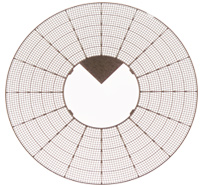Why Designers Should Consider Photo Etching
Designers of precision metal components may face constraints when considering the more well known options for fabricating many flat metal parts. Metal stamping, by far the largest segment of this market, requires hard metal tooling that can produce burrs and cold working. Laser cutting and wire EDM can impart excessive heat to the work object that may alter the characteristics of the metal. And in all of the cases, the more complex the part is the greater the impact on cost.

Photo etching avoids all of those challenges. Phototools run about $300, no matter how complex the part, and can be had in a day or two.
In the chemical etching process, there is no metal-on-metal contact that is pretty much the definition of metal stamping. Therefore, burrs and cold working simply can't happen.
And, the highest moment of heat in the etching process is about 165 F, for a few seconds and about 135 F sustained. So, compared to lasers and EDM at thousands of degrees sustained through the processes, photo etching is barely even warm.
Photo etching is suitable for a wide variety of alloys, including some that are less compatible with other processes. For example, molybdenum-a refractory metal- is difficult to stamp because it can fracture. Aluminum is challenging for lasers because it is reflective, and copper's high thermal conductivity also reduces laser's efficiency. Chemical etching is also more capable in processing very thin materials, routinely down to .001" thickness. Etching is also effective in fabricating braze foil pre-forms in alloys of aluminum, copper, nickel, indium and silver.
In a study conducted under the auspices of the Photo Chemical Machining Institute, a trade organization, cost analyses were performed across multiple fabrication methods, including stamping, laser, water jet, wire EDM and photo etching, using multiple parts of similar size and increasing complexity. We're happy to share that with you here.
The major key to photo etching cost efficiency is dimensional tolerances, which are driven by metal thickness. The standard tolerance band is +/-15% of metal thickness, so that covers drawing block tolerances of +/-.005" for metal thickness up to .032". The practical minimum tolerance is +/-.0015 on metals up to .010".
This chart illustrates the relationship between tolerances, sheet sizes and costs for photo etching. The clear conclusion is that when your design can accommodate a wider tolerance band, there are significant advantages in costs. The point of leverage is the larger the sheet size, the more parts per sheet, since the unit of labor is the sheet.
If you would like a no-obligation drawing review, you can send it to me directly at kstillman@conardcorp.com. Or upload your file here and we'll get back to you right away.

